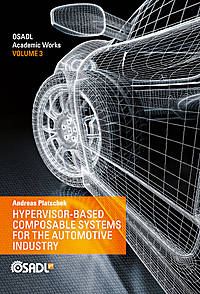Dates and Events:
|
OSADL Articles:
2023-11-12 12:00
Open Source License Obligations Checklists even better nowImport the checklists to other tools, create context diffs and merged lists
2022-07-11 12:00
Call for participation in phase #4 of Open Source OPC UA open62541 support projectLetter of Intent fulfills wish list from recent survey
2022-01-13 12:00
Phase #3 of OSADL project on OPC UA PubSub over TSN successfully completedAnother important milestone on the way to interoperable Open Source real-time Ethernet has been reached
2021-02-09 12:00
Open Source OPC UA PubSub over TSN project phase #3 launchedLetter of Intent with call for participation is now available |
OSADL Academic Works
Vol. 1: Linux in Safety-Critical Applications - Vol. 2: The SCART Hardware-Software Interface - Vol. 3: Hypervisor-Based Composable Systems for the Automotive Industry - Vol. 4: Concept of a Centralized User Configuration (CUC) in Time-Sensitive Networking (TSN) for Industrial Use Cases - Vol. 5: Statistical Path Coverage for Non-Deterministic Complex Safety-Related Software Testing
Vol. 3: Hypervisor-Based Composible Systems for the Automotive Industry
by Andreas Platschek
Following the trend already set by the avionics industry, the automotive industry also is reconsidering its current approach towards on-board electronics and starts to integrate multiple error containment units (ECUs) into a single hardware node. For this approach it is vital to ensure the complete independence of residing applications that often require different levels of safety and security. Independence is achieved by partitioning, i.e. temporal and spatial isolation, supplemented by communication mechanisms that must not impact the isolation. This approach allows the construction of composable systems that simplify the reuse of (legacy) software modules.
Furthermore, the preservation of dependability, safety and security properties of the individual modules is ensured, enabling modular validation and certification. This book approaches the safety aspects by utilizing Open Source software components, but still taking the constraints of the automotive industry into account.
The resulting implementation is able to run several independent automotive applications in parallel on the same processor, rather than requiring a single hardware node for each of them. This approach reduces the number of ECUs in the car, leading to a decrease of power consumption and weight by allowing a higher utilization of the hardware nodes. And, as another welcome advantage, it simplifies inter-node communication.
About the author
Andreas Platschek graduated from the Vienna University of Technology with a degree in Computer Engineering. With a general interest in systems engineering – especially of safety- and mission-critical systems – Andreas Platschek has worked in a variety of academic as well as industrial projects. Andreas‘ special interest lies in the development of strong computing platforms for use in modern software-centered safety-critical applications. He has set his focus on arguing FLOSS software for use in safety-critical systems and has been working in OSADL‘s SIL2LinuxMP project since its early days.





